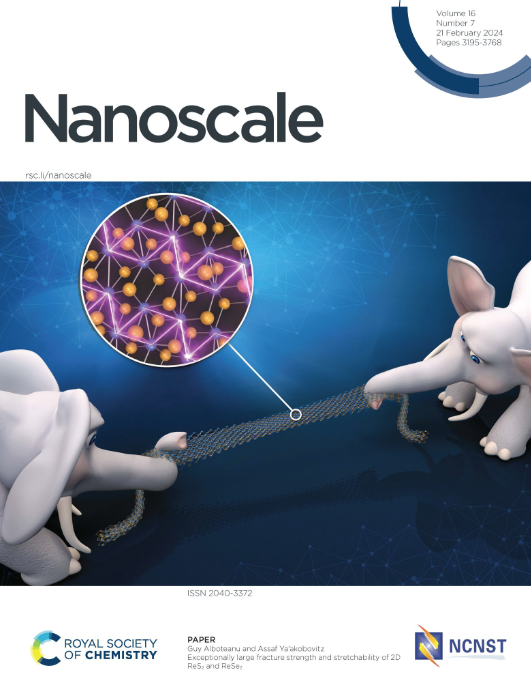量子点注入纳米复合材料:革命性的诊断灵敏度
IF 5.8
3区 材料科学
Q1 CHEMISTRY, MULTIDISCIPLINARY
引用次数: 0
摘要
量子点注入纳米复合材料(qdnc)代表了诊断医学的创新突破,提供无与伦比的灵敏度和特异性。由于量子点具有尺寸可调的光学特性、高量子产率和光稳定性,量子点(QDs)正在成为疾病早期诊断的关键组成部分。通过将量子点集成到纳米复合材料中,诊断能力得到了显著增强,促进了靶向递送、信号放大和多功能。在此基础上建立的平台能够在复杂的生物介质中超灵敏地检测飞摩尔水平的生物标志物,扩大在癌症诊断、传染病和实时血糖监测中的应用。基于量子点的纳米复合材料还包括新的结构设计,如核壳和混合系统,进一步提高稳定性、生物相容性和成像和生物传感性能。表面功能化和绿色合成方法的创新已经克服了与毒性和可扩展性相关的挑战,从而使这些材料更适合临床应用。此外,qdnc与人工智能和机器学习的整合为能够实时分析和个性化医疗的智能诊断平台铺平了道路。本研究调查了qdnc的工程,它们在医疗保健诊断中的变革作用,以及它们革新护理点设备的潜力。解决有关生物相容性、毒性和可扩展性的重大转化挑战的能力将使基于量子点的技术为精确诊断设定新的标准,引领全球医疗保健的新进步。本文章由计算机程序翻译,如有差异,请以英文原文为准。
Quantum Dot-Infused Nanocomposites: Revolutionizing Diagnostic Sensitivity
Quantum dot-infused nanocomposites (QDNCs) represent an innovative breakthrough in diagnostic medicine, offering unparalleled sensitivity and specificity. Due to their size-tunable optical properties, high quantum yield, and photostability, quantum dots (QDs) emerging as pivotal building blocks in the early diagnosis of diseases. Through the integration of QDs into nanocomposites, a significant enhancement in diagnostic capabilities has occurred, facilitating targeted delivery, signal amplification, and multi-functionality. A platform established on such advancements enables the ultra-sensitive detection of biomarkers at the femtomolar level in complex biological media, expanding applications within cancer diagnostics, infectious diseases, and real-time glucose monitoring. QD-based nanocomposites also encompass novel structural designs such as core-shell and hybrid systems that further enhance stability, biocompatibility, and performance in imaging and biosensing. Innovations in surface functionalization and green synthesis methods have surmounted challenges related to toxicity and scalability, thereby rendering these materials more suitable for clinical applications. Furthermore, the integration of QDNCs with artificial intelligence and machine learning is paving the way towards intelligent diagnostic platforms capable of real-time analysis and personalized medicine. This study investigates the engineering of QDNCs, their transformative role in healthcare diagnostics, and their potential to revolutionize point-of-care devices. The capability to address significant translational challenges concerning biocompatibility, toxicity, and scalability will position QD-based technologies to set a new standard for precision diagnostics, ushering in new advancements in global healthcare.
求助全文
通过发布文献求助,成功后即可免费获取论文全文。
去求助
来源期刊

Nanoscale
CHEMISTRY, MULTIDISCIPLINARY-NANOSCIENCE & NANOTECHNOLOGY
CiteScore
12.10
自引率
3.00%
发文量
1628
审稿时长
1.6 months
期刊介绍:
Nanoscale is a high-impact international journal, publishing high-quality research across nanoscience and nanotechnology. Nanoscale publishes a full mix of research articles on experimental and theoretical work, including reviews, communications, and full papers.Highly interdisciplinary, this journal appeals to scientists, researchers and professionals interested in nanoscience and nanotechnology, quantum materials and quantum technology, including the areas of physics, chemistry, biology, medicine, materials, energy/environment, information technology, detection science, healthcare and drug discovery, and electronics.
 求助内容:
求助内容: 应助结果提醒方式:
应助结果提醒方式:


